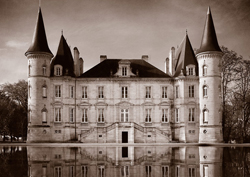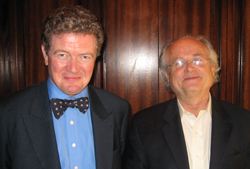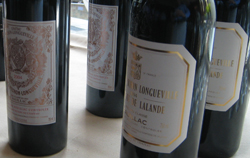A tale of two Pichons – peace in Pauillac
Rivalries and conflicts simmer throughout the world. At least one was resolved peacefully last week in a historic vertical tasting of the wines of the two Pichons.
 Around 1850, faced with the inheritance laws of the Napoleonic code, Baron Pichon split his Pauillac estate among his five children: his three daughters got the larger share of the property but his two sons inherited the chateau itself and two-fifths of the vineyard. This action not only set up a rivalry between the two properties but also doomed legions of wine consumers to confusion between the two adjacent estates now colloquially known as Pichon-Baron or Pichon-Lalande.
Around 1850, faced with the inheritance laws of the Napoleonic code, Baron Pichon split his Pauillac estate among his five children: his three daughters got the larger share of the property but his two sons inherited the chateau itself and two-fifths of the vineyard. This action not only set up a rivalry between the two properties but also doomed legions of wine consumers to confusion between the two adjacent estates now colloquially known as Pichon-Baron or Pichon-Lalande.
In the 1987, AXA Millésimes, the wine holding unit of the multinational insurance group based in Paris, bought Pichon Baron, which had fallen into disrepair. Jean-Michel Cazes of Chateau Lynch Bages ran the operations, which included upgrading the winemaking as well as overseeing a renovation the cellars and the chateau. But according to one account, tensions escalated between the two estates as Cazes laid claim to the Pichon name calling the property simply Chateau Pichon-Langueville with no reference to “Baron,” much to the dismay of Mme May-Eliane de Lencquesaing of Pichon-Lalande! In late 2006, Mme de Lencquesaing, in her eighties, confronted the same inheritance laws that had divided the original property. Rather than seeing it torn asunder, she sold a majority stake to the Rouzaud family of Champagne (Roederer).
 The managing directors of both properties convened on New York for a tasting at the Wine Media Guild on April 27. Christian Seely, wearing his trademark bow tie, represented Baron while Gildas d’Ollone, formerly a professional opera singer who has overseen the last twenty vintages of Pichon Lalande, represented the Comtesse. Members and their guests packed the private dining room to (over)capacity.
The managing directors of both properties convened on New York for a tasting at the Wine Media Guild on April 27. Christian Seely, wearing his trademark bow tie, represented Baron while Gildas d’Ollone, formerly a professional opera singer who has overseen the last twenty vintages of Pichon Lalande, represented the Comtesse. Members and their guests packed the private dining room to (over)capacity.
First up was a walk around tasting of both the wines from 2000-2006. Unfortunately the room was quite a tight space, which made taking detailed notes problematic. Here are some rapid fire observations from this portion: Pichon-Lalande has a higher proportion of merlot in the final blend; coincidentally, it slightly rounder than its cabernet dominant neighbor, which may be why some who use anachronistically ascribe gender to wine attributes consider it the more “feminine” of the duo. I found the 00 and 04 Lalandes the unfortunately disappointing from this portion; the 2002 was particularly lovely, especially given the vintage; and the 03, 05, 06 were richer, with 06 carrying the style most successfully. On the Pichon-Baron side, things are really cranking under Christian Seely who took over in 2000, which produced an excellent wine. Of the 01, 02, 04 vintages, I preferred the 01 and 04. The 2005 was fantastic and the 06 excellent.
At lunch, we heard from our speakers who both talked about changes in vineyard practices with d’Ollone specifically pointing to deleafing, yield management, and grape ripeness, which, he said, explains why they haven’t used “concentration systems in the past five to seven years.” In the discussion about historical yields, both the speakers praised moderately high yields with d’Ollone pointing to the coincidence of high yields high quality in the 82 and 89 vintages while Seely talked of a balance, above “garagiste” levels and below the high levels of some years gone by.
 Seely flashed his wit on at least a couple of occasions. Mark Golodetz, the member who coordinated the lunch, brought up the recent posts on this site pertaining to the policy and practice at The Wine Advocate and recommended it to everyone as a good springboard for a discussion about ethics and wine writing. Seely then deadpanned, “I’ve always found wine writers distressingly incorruptible!”
Seely flashed his wit on at least a couple of occasions. Mark Golodetz, the member who coordinated the lunch, brought up the recent posts on this site pertaining to the policy and practice at The Wine Advocate and recommended it to everyone as a good springboard for a discussion about ethics and wine writing. Seely then deadpanned, “I’ve always found wine writers distressingly incorruptible!”
The 2008 vintage also came up in the discussion: d’Ollone said that they had priced the Lalande 08 futures already and had sold directly in China for the first time since eight is a lucky number there. Guild member Peter Sichel opined that the 2008 vintage “is an enormous opportunity” given the quality and the pullback in demand. After a brief discussion about the vintage of the decade, Christian Seely again deadpanned “I want to be clear: 2009 really is the vintage of the century.”
Putting away the crystal ball, we were able to look backward instead in our crystal glasses. With lunch we had both the wines from 1990, which, unfortunately didn’t show well. But the 1989s were superb in both cases–truly exceptional wines that still have many years in front of them. We also had a 1975 Pichon-Lalande from a double magnum, courtesy of one of a member’s guest. The wine was still intact, with high acidity, but it was a good thing that we drank it that day. But the wine of the lunch was the 1985 Pichon-Lalande, which had a beautiful patina of age, with a beautiful subtle intensity, and a long and satisfying finish. When Cabernet is on, man, it can be on fire.
D’Ollon declared the lunch a “historic event.” Now that there’s peace in Pauillac, hopefully more Pichon-Pichon tastings will occur around the world. Sign up for one if you can.
Find Chateau Pichon-Longueville Baron wines at retail (or visit the Baron web site)
Find Chateau Pichon-Longueville Lalande wines at retail (or visit the Lalande web site)




On May 5th, 2009 at 3:40 pm ,Wine Media Guild of New York » Pichon-Lalande and Pichon-Baron at the Wine Media Guild - a “historic event” wrote:
[…] Robert Simonson (Off the Presses): Pichon-Baron Pichon-Lalande Showdown Tyler Colman (Dr. Vino): A tale of two Pichons – peace in Pauillac […]
On May 7th, 2009 at 7:17 pm ,Dylan wrote:
Seely seems to have some sharp wit. I let out a good laugh at his wine writer’s ethics commentary.
On May 7th, 2009 at 7:20 pm ,Robert Simonson wrote:
Nice write-up. Though I like the 2000 Lalande more than you did.